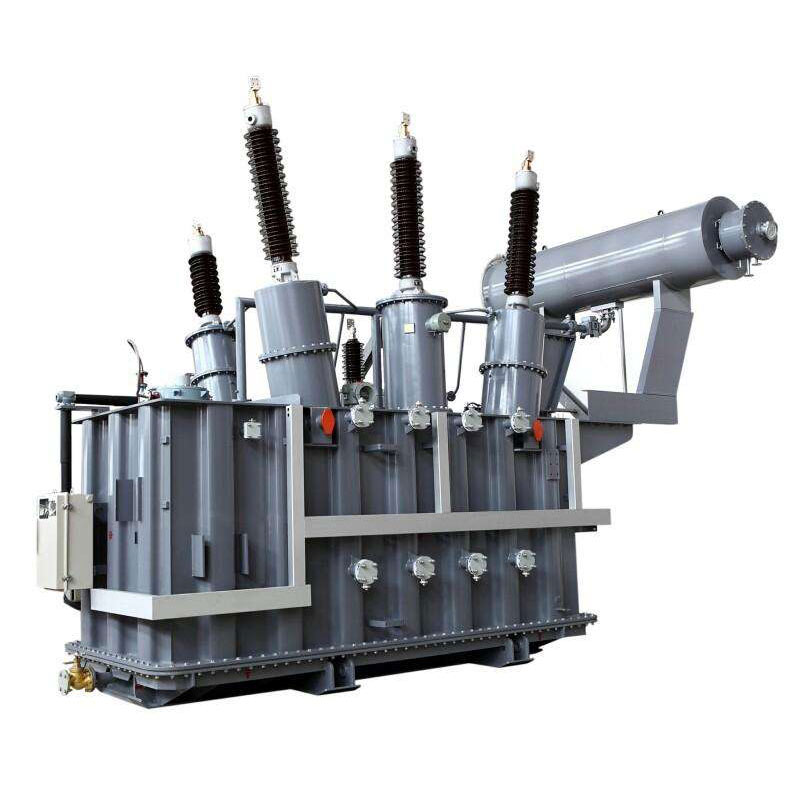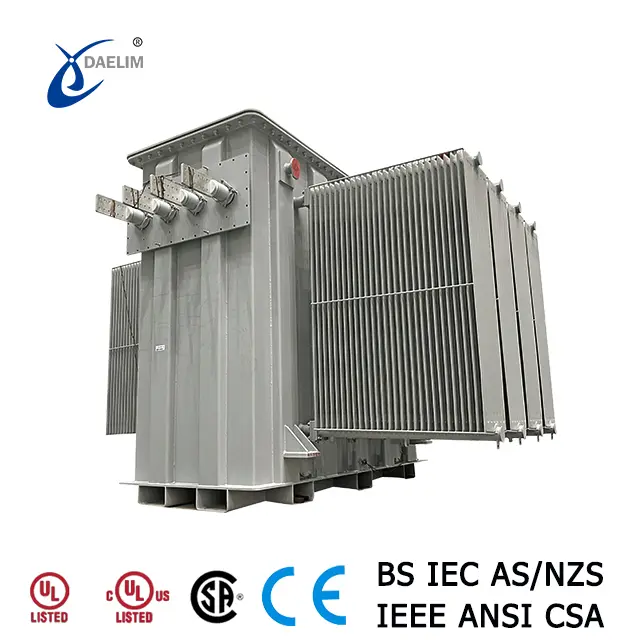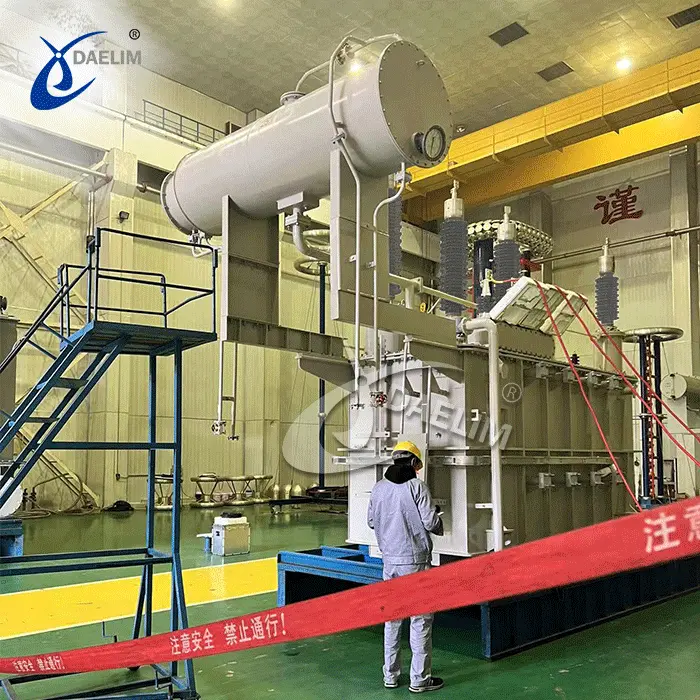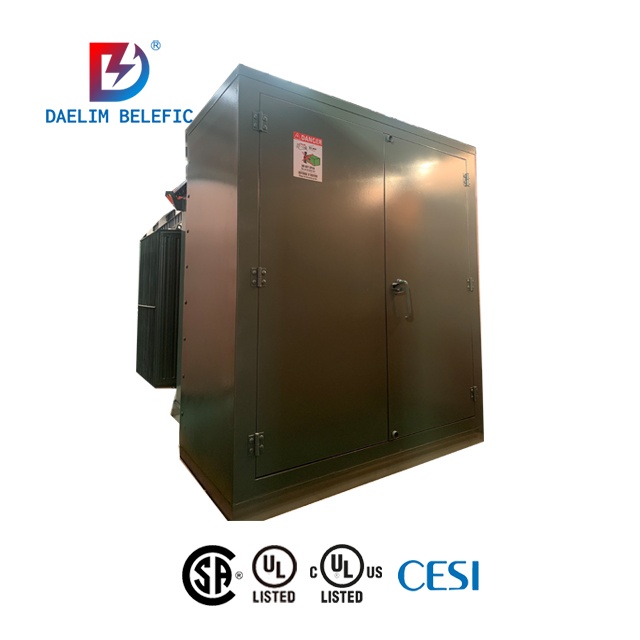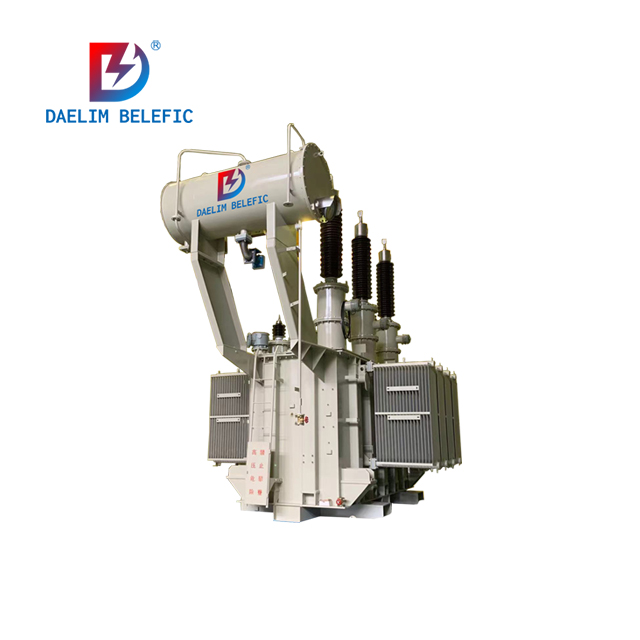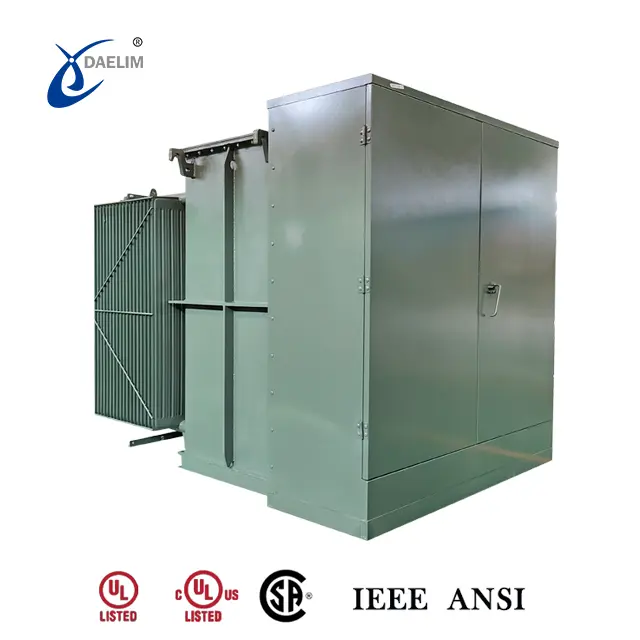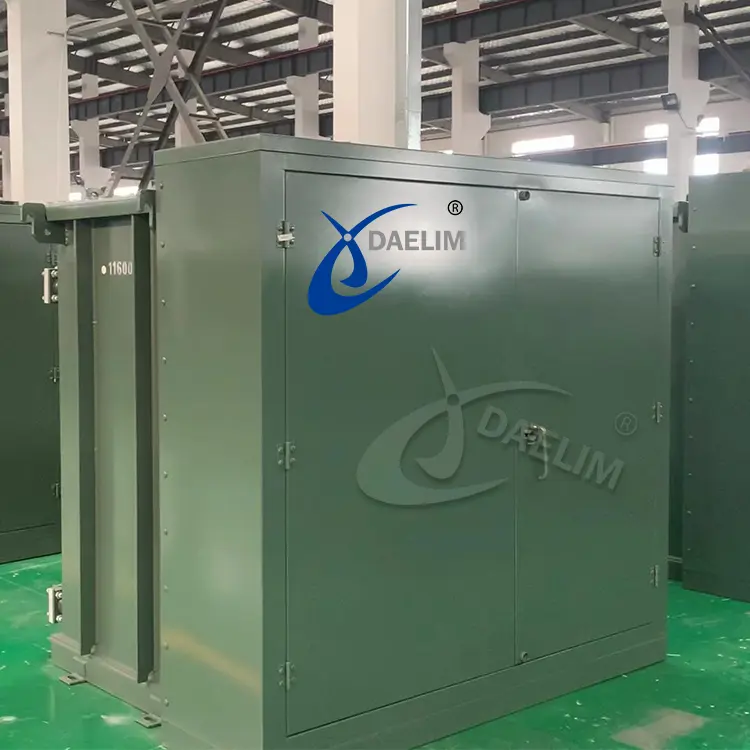Daelim Transformers Solution For Renewable Power Plant

Daelim offers exceptional transformer solutions that cater to the specific needs of renewable power plants. These plants, such as wind farms and solar energy plants, require dependable and effective solutions to efficiently transfer the energy they generate to the electrical grid.
Daelim's proficiency in creating and producing transformers for power transmission and distribution systems can be modified to cater to renewable energy plants. Daelim can provide transformers that can back the appropriate voltage levels and load types to fit the distinct needs of renewable power plants.
Daelim offers tailored transformer solutions for renewable power plants, considering the specific environmental conditions that may impact transformer performance. These transformers are designed to endure extreme weather and temperature changes, guaranteeing their dependable operation over a prolonged period.
Contact Daelim TransformerDaelim Transformer Solution For Renewable Power Plant
Daelim Transformers offers comprehensive solutions for Renewable Power Plants, focusing on delivering reliable and efficient power transmission solutions for renewable energy generation fields. The company's product range includes power substations and pad-mounted transformers, which are suitable for use in Renewable Power Plants. These transformers can be seamlessly integrated into the grid and connected to transmission lines.
Daelim Transformer has successfully executed numerous projects related to Renewable Power Plants across various markets, including the United States, Canada, and other regions. These projects demonstrate the company's expertise and commitment to supporting the renewable energy sector.
Project Site: Pennsylvania, USA
In this solar power generation project located in Pennsylvania, there is a requirement for five power transformers. These transformers have specific technical parameters based on the project's needs. Here are the details:
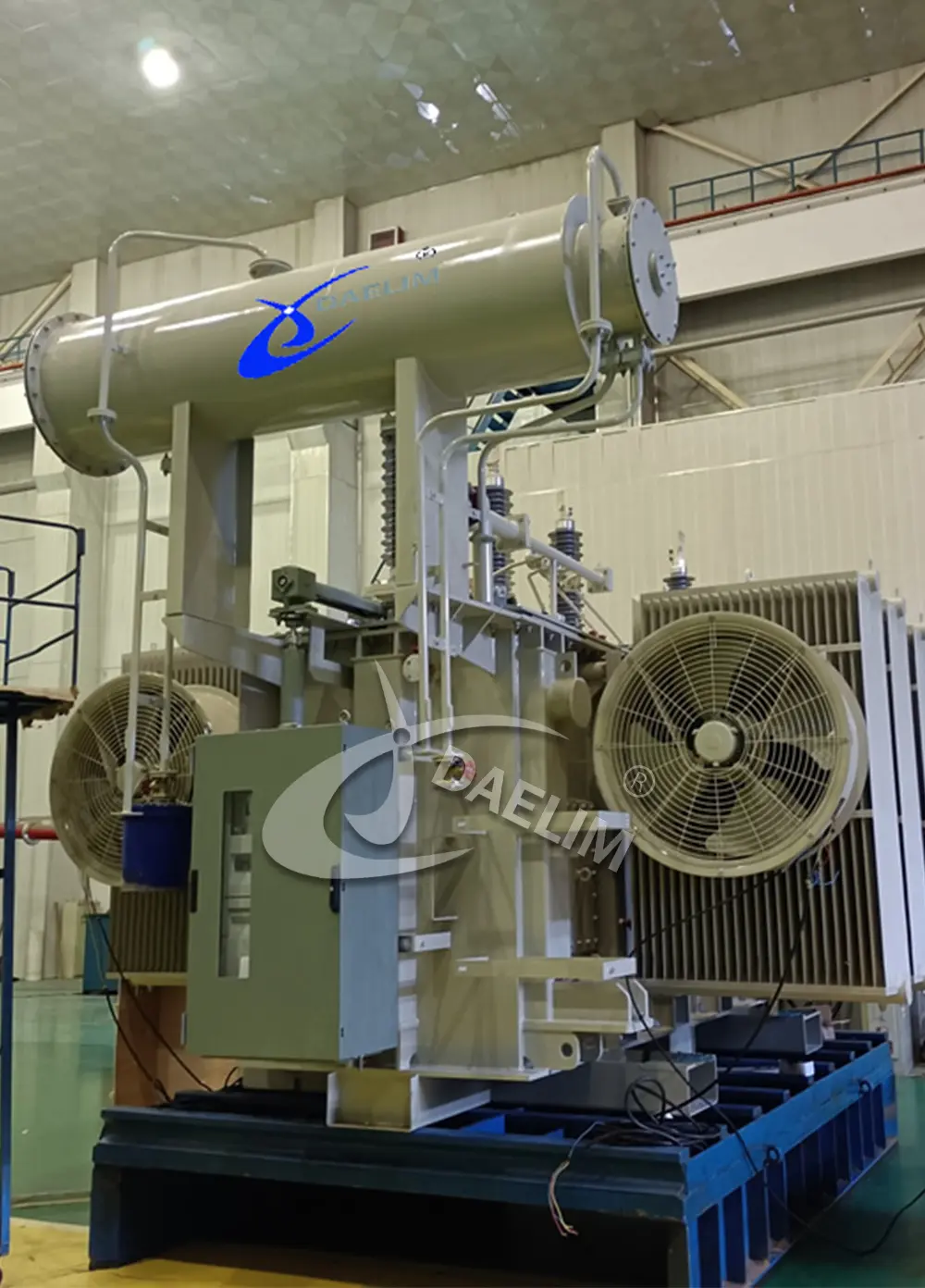
46/34.5/13.8kV 16.2 / 21.6 / 27 MVA Power Transformer
Quantity:2
Type:Oil-Filled, Outdoor, Station Type, Power Transformer
Continuous Rating:16.2 / 21.6 / 27 MVA
Cooling Class: ONAN/ONAF1/ONAF2
Temperature Rise: 65°
HV Winding: 46 kV
LV Winding: 34.5 kV
Tertiary:13.8 kV
Frequency: 60Hz
Winding Material HV/LV: Copper/Copper
Coil Construction: Detailed Description By Vendor
Impedance, at ONAN Rating: 8.5%
Tap Changer: 5 positions De-energized
HV Bushings Location: Top Cover
Ambient Temperature: -20°F-110°F
Send Inquiry Now138/34.5/13.8kV 50 / 67 / 83 MVA Power Transformer
Quantity:1
Type:Oil-Filled, Outdoor, Station Type, Power Transformer
Continuous Rating:50/67/83 MVA
Cooling Class: ONAN/ONAF1/ONAF2
Temperature Rise: 65°
HV Winding: Gnd Wye 138 kV
LV Winding: Gnd Wye 34.5 kV
Tertiary:Buried Delta 13.8 kV
Frequency: 60Hz
Winding Material HV/LV: Copper/Copper
Coil Construction: Detailed Description By Vendor
Impedance, at ONAN Rating: 9%
Insulation Liquid: Standard: Mineral Oil per ASTM D3487
Radiator Finish: Galvanized and painted ANSI #70 gray
Transformer Paint Color: ANSI # 70 Gray
Contact Daelim Transformer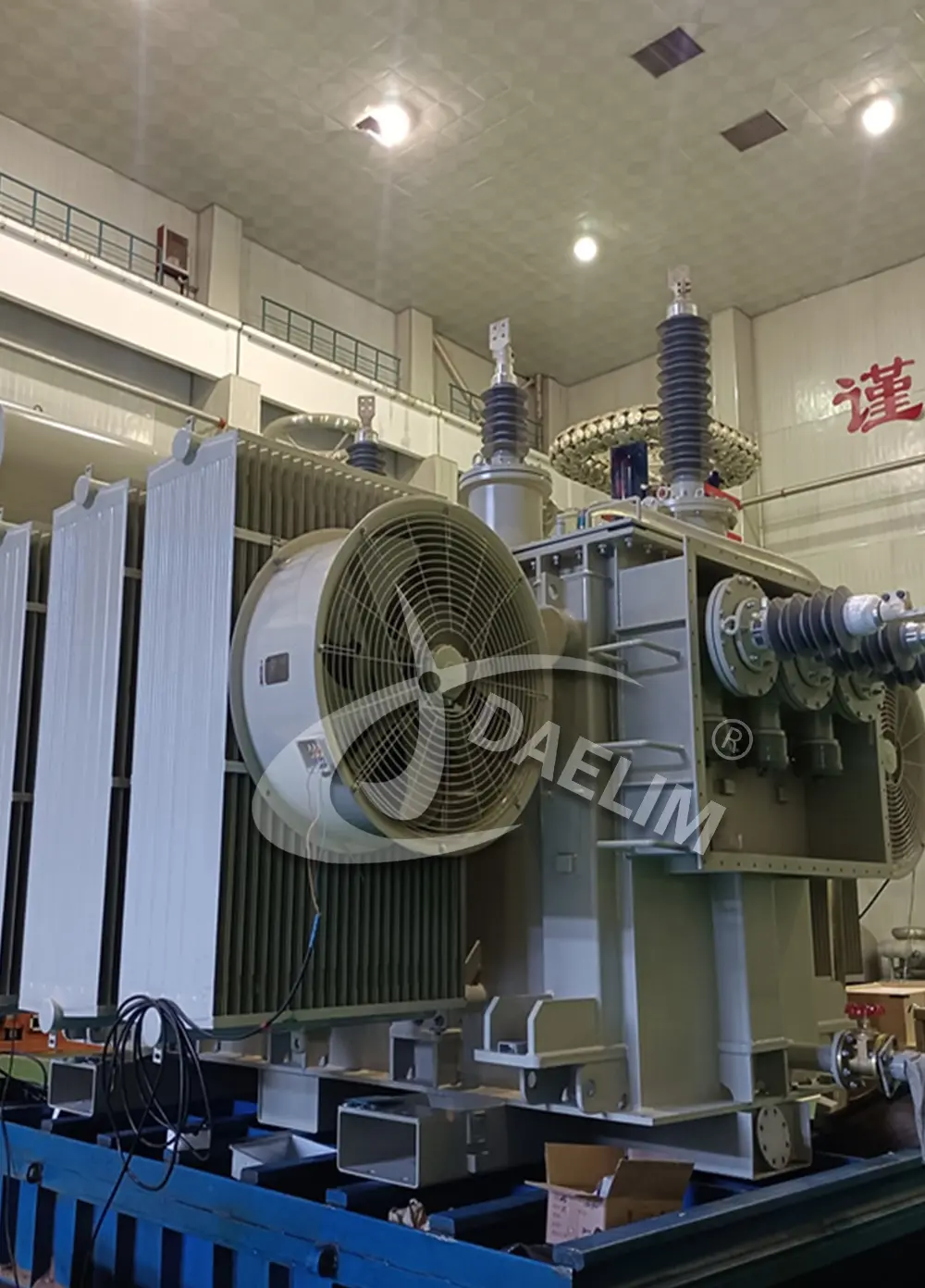
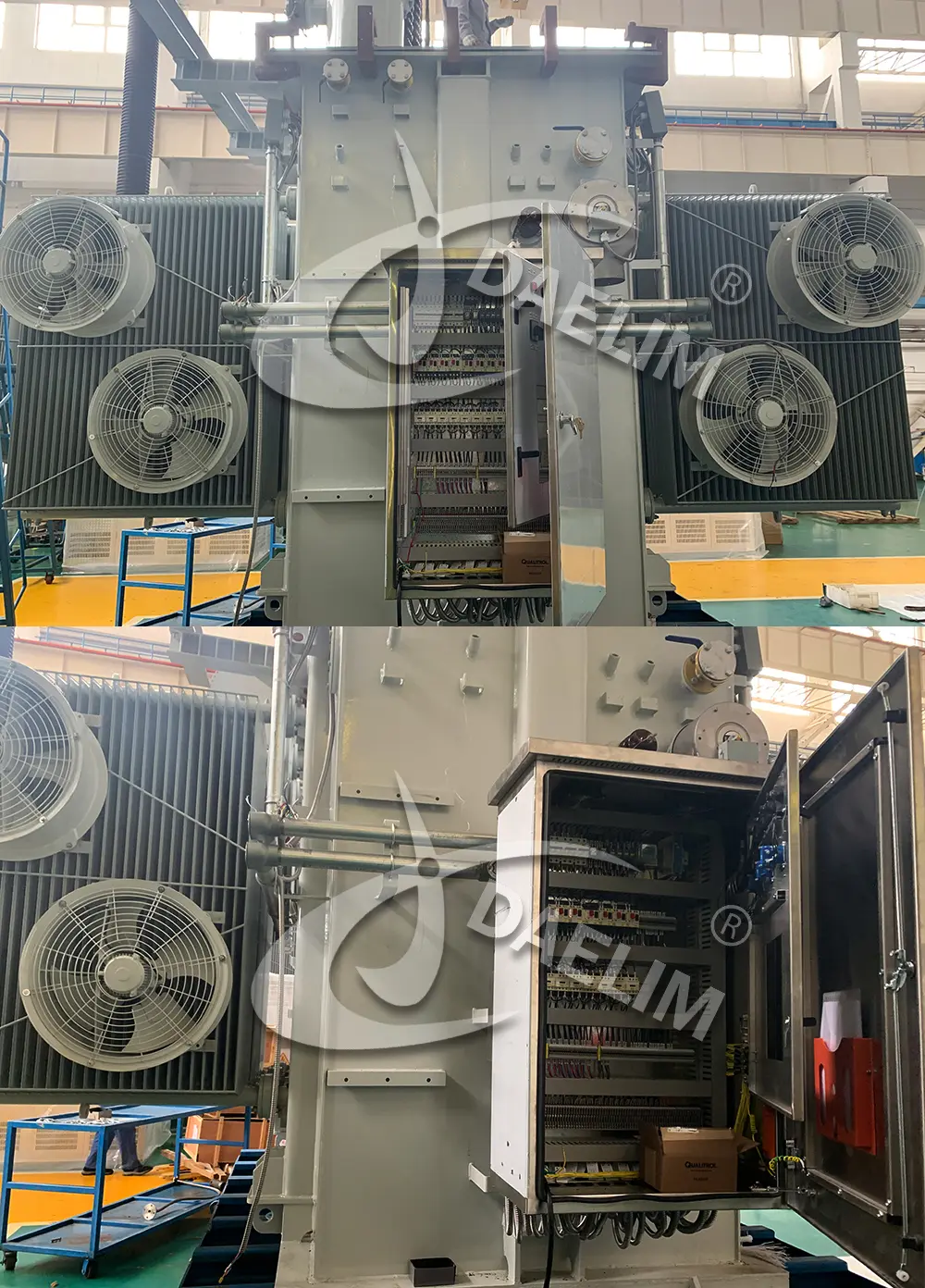
69/34.5/13.8kV 33 / 44 / 55 MVA Power Transformer
Quantity:1
Type:Oil-Filled, Outdoor, Station Type, Power Transformer
Continuous Rating:33 / 44 / 55 MVA
Cooling Class: ONAN/ONAF1/ONAF2
Temperature Rise: 65°
HV Winding: 138 kV Gnd Wye
LV Winding: 34.5 kV Gnd Wye
Tertiary:13.8 kV Buried Delta
Frequency: 60Hz
Winding Material HV/LV: Copper/Copper
Coil Construction: Detailed Description By Vendor
Impedance, at ONAN Rating: 8%
Core Construction: Core
HV Bushings Location: Top Cover
Oil Preservation System: Nitrogen Blanket
Get Price138/34.5/13.8kV 33 / 44 / 55 MVA Power Transformer
Quantity:1
Type:Oil-Filled, Outdoor, Station Type, Power Transformer
Continuous Rating:33 / 44 / 55 MVA
Cooling Class: ONAN/ONAF1/ONAF2
Temperature Rise: 65°
HV Winding: 138 kV
LV Winding: 34.5 kV
Tertiary:13.8 kV
Frequency: 60Hz
Winding Material HV/LV: Copper/Copper
Coil Construction: Detailed Description By Vendor
Impedance, at ONAN Rating: 9%
Tap Changer: 5 positions De-energized
HV Bushings Location: Top Cover
Oil Preservation System: Nitrogen Blanket
Get Price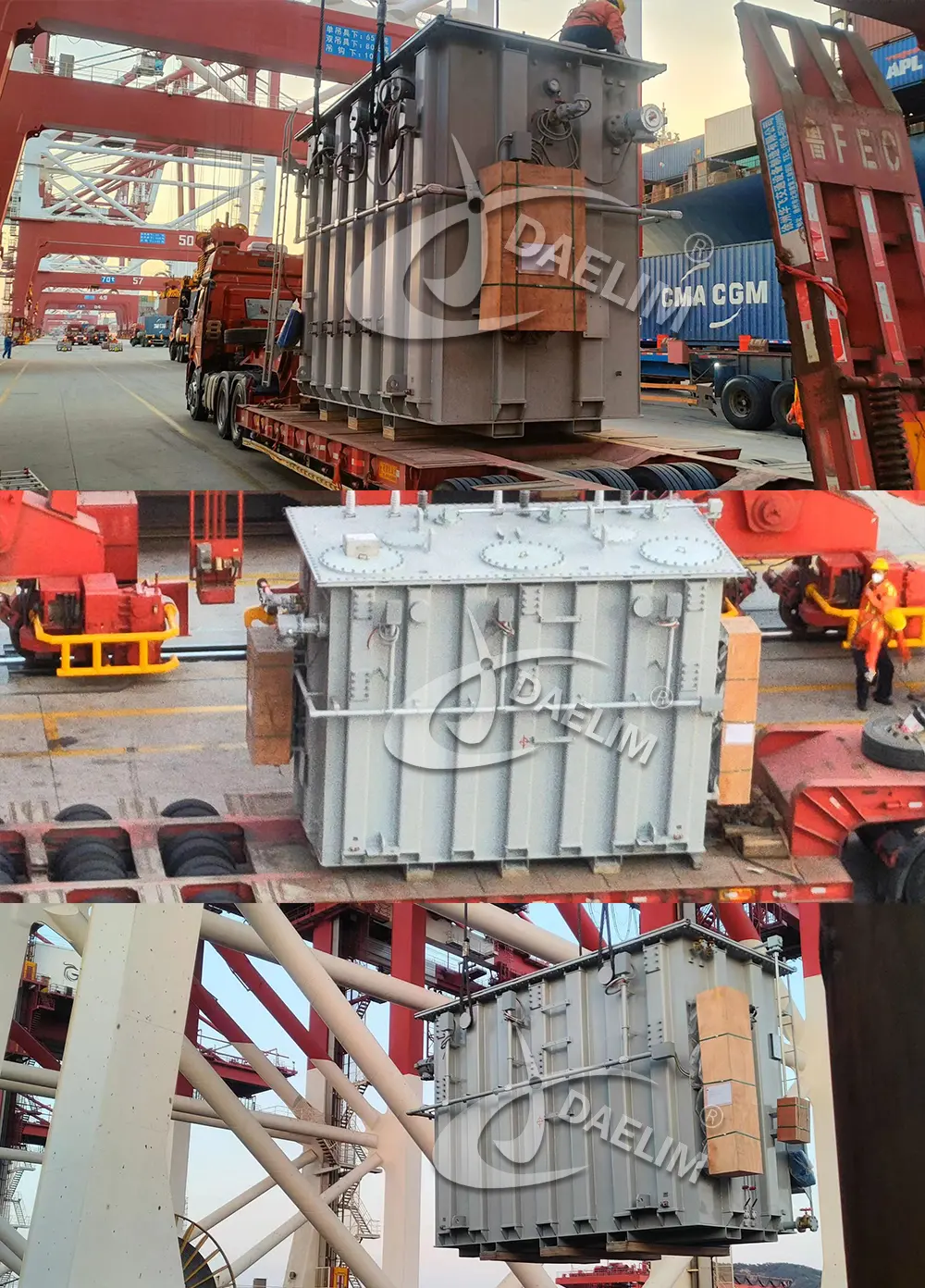
Learn more about Daelim Solar Photovoltaic System Solution
Overview of renewable power plants
As the world focuses on sustainability, the need for renewable energy solutions has become more vital than ever. Renewable power plants are at the forefront of this movement, utilizing various sources such as wind, solar, tidal, and geothermal energy to meet the increasing demand for clean energy. To ensure optimal use of these sources, well-designed power plants that can efficiently handle energy requirements are essential. One crucial element of such designs is incorporating transformers, which play a critical role in boosting voltage levels for long-distance power transmission, while also providing isolation and voltage regulation.
Importance of transformers in renewable power generation
Transformers are crucial in efficiently managing the energy demand of renewable energy power plants. Their primary function is to increase the voltage level of power transmission over long distances and provide insulation between different circuits. Moreover, they can store energy, ensuring uninterrupted power supply during periods of high demand. In the case of wind and solar as renewable energy sources, transformers become even more significant as they generate electricity at higher voltages, minimizing energy loss during transmission over long distances.
For the smooth operation of a renewable power plant, transformers are a critical component in its design. Proper sizing, location, and monitoring of transformers are crucial to ensure the continuous and smooth operation of a renewable power plant, leading to a more sustainable future. As renewable energy sources become increasingly important, transformer designers must continue to improve their designs and remain up-to-date with the latest advancements.
Types of Renewable Power Plants
As society seeks ways to minimize carbon emissions and move away from fossil fuels, renewable power plants have gained significant importance. These power plants come in different types, each with its advantages and disadvantages.
A. Solar power plants
Factories utilize photovoltaic panels to harness the power of the sun and convert it into electricity. Solar energy is advantageous because it is widely accessible without any emissions or fuel expenses. Nevertheless, the efficiency of this technology is impacted by weather conditions, and it demands a substantial amount of space to generate significant amounts of power.
B. Wind power plants
These plants use turbines to harness the power of the wind to generate electricity. Wind power is clean, efficient, and has a low carbon footprint. However, wind turbines can be noisy and visually intrusive, and the availability of consistent wind is reliant on weather patterns.
C. Hydroelectric power plants
Renewable energy is often generated by hydroelectric plants, which harness the power of flowing water to generate electricity through turbines. Hydroelectricity is a clean, efficient, and dependable source of energy, with the added advantage of being able to store energy for future use. However, the construction of dams or reservoirs can have a significant environmental impact and comes at a high cost.
D. Biomass Power Plants
Organic materials like wood, agricultural waste, and biogas are used in biomass power plants to produce electricity. This renewable source of energy helps reduce waste and emissions from burning these materials. However, the collection and transportation of biomass can be costly, and the burning process emits greenhouse gases.
E. Geothermal Power Plant
Did you know that we can generate electricity by using the earth's natural heat? Geothermal power plants make this possible by capturing geothermal energy through a series of pipes and heat exchangers. This renewable energy source is reliable, sustainable, and produces no harmful emissions. However, building geothermal power plants can be costly, and the availability of geothermal resources may vary.
Role of Transformers in Renewable Power Plants
A. Voltage transformation and power distribution
Transformers play a vital role in the conversion of electricity produced by renewable energy plants. Solar panels and wind turbines generate low voltages, which must be increased to higher levels for efficient distribution and transmission over long distances. To achieve this, transformers are utilized to step up the voltage. Similarly, when the generated electricity is consumed locally, a transformer is necessary to step down the voltage to make it suitable for domestic and commercial usage.
B. Grid integration and synchronization
Renewable power plants are integrated into the electricity grid to supplement the energy generated by traditional power sources. To integrate renewable energy into the grid, transformers are used to convert the electricity generated into a synchronized frequency and phase that is compatible with the grid. The synchronization process involves adjusting the voltage and frequency of the electricity generated by the renewable power plant to match that of the grid.
C. Reactive power compensation and voltage regulation
Transformers are also responsible for compensating for the reactive power generated by renewable sources such as solar and wind power plants. To maintain voltage levels in the grid, reactive power is necessary. Transformers play a crucial role in providing this compensation by either adding or removing reactive power, as needed. Additionally, transformers help regulate voltage levels in the grid by controlling current flow and ensuring a stable voltage level, which helps prevent power fluctuations.
D. Power quality and stability
Transformers play a critical role in maintaining power quality and stability in the grid. They ensure that the power transmitted through the grid is free from voltage fluctuations and harmonics, which can cause damage to electrical equipment and affect power quality. Transformers also help to protect the grid from sudden changes in demand or supply by providing a buffer that can absorb excess electricity or provide additional power when demand increases.
Transformer Solutions for Renewable Power Plants
A. Design considerations for transformers in renewable power plants
The design and implementation of transformers are crucial for ensuring the longevity and effectiveness of power plants, as they play a vital role in their operation. When designing transformers for renewable energy power plants, certain factors must be taken into account, including:
1. Power rating and capacity
Power Rating and Capacity Transformers in renewable power plants need to be sized correctly to handle the power generated by the plant. The power rating of the transformer should be higher than the power generated by the plant to manage any unexpected spikes in power output.
2. Efficiency and losses
Efficiency and Losses Efficiency is critical in a power plant as it helps to reduce energy wastage and keep operating costs low. Transformers should have high efficiency to reduce energy losses due to heat dissipation. The core and winding materials used in transformers should be chosen with care to minimize losses due to hysteresis and eddy currents.
3. Cooling mechanisms and thermal management
Cooling Mechanisms and Thermal Management Transformers are prone to overheating, which can reduce the lifespan of the transformer or cause it to fail. Proper cooling mechanisms such as natural convection, forced air cooling, or liquid cooling should be employed to manage transformer temperature and ensure safe and efficient operation. Thermal management systems such as insulation and cooling fins should also be implemented to ensure optimal heat transfer.
B. Transformer types for different renewable power plant applications
Transformer Types for Different Renewable Power Plant Applications Transformers in renewable power plants come in various types and configurations, depending on the power plant’s technology and the role the transformer plays. The following are the types of transformers commonly used in renewable power plants.
1. Step-up transformers for solar and wind power plants
Step-up Transformers for Solar and Wind Power Plants Step-up transformers are used in both solar and wind power plants to increase the voltage level to the grid. These large power transformers are designed for high voltage levels and are usually water-cooled. The generator is linked to the transformer, and the transmission system is connected to its output.
2. Step-down transformers for hydroelectric and biomass power plants
Step-down Transformers for Hydroelectric and Biomass Power Plants Step-down transformers are used in hydroelectric and biomass power plants to reduce high voltage levels to lower levels suitable for transmission to the grid. These transformers are small and do not require cooling systems as they handle low voltage levels. The transformer is connected to the generator, and its output is connected to the distribution system.
3. Generator step-up transformers for geothermal power plants
Generator Step-up Transformers for Geothermal Power Plants Generator step-up transformers (GSU) are used in geothermal power plants to step up the voltage generated by the turbine generator to the transmission system. These transformers are specially designed for high-temperature environments and have robust insulation systems. GSUs are usually oil-cooled, but some newer designs employ synthetic ester fluids to reduce fire hazards.
C. Case studies of transformer solutions in renewable power plants
Case Studies of Transformer Solutions in Renewable Power Plants The following are case studies of transformer solutions in renewable power plants.
Campo Verde Solar Facility, Arizona The Campo Verde Solar Facility is a 139 MW solar power plant that relies on step-up transformers to increase the voltage output from 34.5 kV to 138 kV for transmission to the grid. The transformers used in this project were custom-designed to handle the high voltage levels and have efficient cooling systems to reduce heat dissipation.
Vaxjo Biomass Power Plant, Sweden The Vaxjo Biomass Power Plant generates 38 MW of electricity and relies on step-down transformers to reduce the voltage output from 20 KV to 6 KV for distribution to the grid. The transformers used in this project are small and do not require cooling systems, making them suitable for the low voltage levels handled.
The Geysers Geothermal Power Plant, California The Geysers Geothermal Power Plant is a 725 MW facility that relies on GSUs to step up the voltage generated by the turbine to 230 KV for transmission to the grid. The GSUs used in this project are oil-cooled and have reliable insulation systems to handle the high-temperature environment.
Challenges and Solutions in Transformer Design for Renewable Power Plants
Designing transformers plays a crucial role in renewable energy facilities as it ensures the produced power is in line with grid standards and regulatory guidelines. The design process is often complicated due to factors such as inconsistent power generation, adherence to grid codes and regulations, harmonic distortion, power quality concerns, and maintenance and protection of transformers.
A. Variable and Intermittent Power Generation
Solar and wind power generation is naturally unpredictable and fluctuates based on weather conditions. This can cause voltage and frequency levels to vary, potentially damaging transformers and other components. Additionally, these fluctuations can lead to significant power loss, resulting in inefficiencies. To address these issues, smart transformer designs are necessary. They should also be equipped with robust insulation and cooling systems to withstand output power fluctuations. Quality monitoring systems are also crucial to detect and report any abnormalities in power generation during plant operation.
B. Grid Codes and Compliance Requirements
When it comes to operating power transmission systems safely and reliably, grid codes provide essential guidelines. Renewable power plants must comply with these codes to integrate into the grid. That's why transformer design should always consider the specific grid codes and compliance requirements of the plant's jurisdiction.
To meet these requirements, transformers for renewable power plants must comply with the grid codes of the region, including regulations for voltage regulation, protection against overvoltage and overcurrent, and short-circuit protection. Additionally, these transformers must meet regulations about environmental operating conditions, such as temperature, altitude, and seismic resistance.
C. Harmonic Distortion and Power Quality Issues
Renewable power plants generate non-sinusoidal waveforms that cause harmonic distortion and power quality issues. The increased presence of harmonics in the power system can damage the transformer and other electrical equipment, leading to efficiency loss and potential equipment failures.
The solution to this problem lies in the use of special transformer designs that can limit the effects of harmonics. The transformer must have special high-voltage insulation systems that prevent voltage surges and transient currents. In addition, the transformer designs should limit the voltage and frequency fluctuations during the operation of the power plant.
D. Transformer Protection and Maintenance Considerations
Transformers play a crucial role in renewable power plants, and if they malfunction, they can cause severe damage to other components in the system. Thus, it's vital to incorporate protective measures in the transformer design to prevent overloading, overheating, and short-circuiting.
To reduce the risk of transformer failure, the design must consider various operating conditions like temperature, humidity, wind speed, and altitude. Adequate cooling systems must be in place to dissipate the heat generated by the transformer during operation. Moreover, it's essential to have a reliable monitoring system that detects any anomalies in the power delivery and generates alerts for maintenance and repairs.
At Daelim, their transformer products for renewable power plants undergo rigorous testing and inspection procedures, just like all of their solutions. This guarantees that they are of high quality and able to meet the demanding global standards for safety and performance.
In summary, Daelim's versatile, reliable, and high-quality transformer solutions are ideal for renewable power plants. Whether it's for solar energy plants or wind farms, Daelim's expertise in transformer technology can help produce clean energy that can be efficiently and reliably delivered to the electrical grid.
Contact Daelim Transformer
